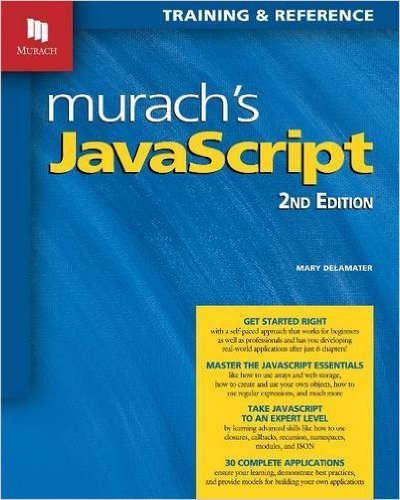| Murach's JavaScript, 2nd Ed |
Authors: Joel Murach and Michael Urban Another book on core JavaScript - does this one have anything extra to offer? Murach's books on technical topics are a well known series and they follow a fairly standard pattern which you either love or hate. To be honest there isn't much to hate about them because they don't go in for anything revolutionary by way of presentation. In this case the topic is JavaScript and it is covered in a workmanlike fashion and from the simple stuff to the advanced. This is also a book that teaches you JavaScript as a scripting language used in web pages. The first section, Get off to a fast start with Javascript, is a lightning tour of using JavaScript in a web page. Chapter 1 explains what you need to know about HTML and CSS and how to get JavaScript working in the page. This isn't really enough information and in practice if you are a beginner at HTML/CSS you are going to find things tough going. My advice would be to learn at least the principles of HTML/CSS before trying to learn JavaScript. From here the book works though using JavaScript with HTML. Chapter 2 introduces datatypes and Chapter 3 introduces the control statements. Although the explanations are clear they don't really try to teach you the fundamentals of programming. If you are beginner struggling to understand conditionals or loop or even the general idea of flow of control this is going to be much to fast for you. It also has a tendency to introduce advanced material in an attempt to be complete. Chapter 4 explains object and functions and how to hookup events and Chapter 5 deals with applying your JavaScript to work with forms and other HTML controls. The final chapter of the section explains debugging but with specific reference to Chrome's developer tools with a brief mention of IE. If you are completely new to programming this first section is probably going to be too fast for you. If you read it through you will see what JavaScript can do and you will get some way but you are likely to be fustrated if you aren't up on HTML/CSS and are finding programming tough. If on the other hand you have been using HTML/CSS then this is a good way to graduate to using some JavaScript.
The second section is called JavaScript essentials and it is a more complete and logical introduction to the language. Chapter 7 goes over data types numbers, strings and dates. Chapter 8 introduces control statements again and in this case it tends to mix simple things with the advanced. For example there is a lot about logical expressions, the full extent of If statement nesting, the switch statement and even the conditional operator. As long as you don't try and take it all in in a single go you should be okay. Chapter 9 is slightly odd in that it introduces the array and web storage. The array is a fundamental data type in JavaScript but web storage is an add-on API. Very useful but not really in the same category and why no explanation of how to use basic cookies? Chapters 10 and 11 deal with functions and objects and at this point things are starting to get advanced. JavaScript is at its most subtle when it comes to functions and objects and this book takes you so far but not quite far enough. I'm not convinced that the reader will get all of the ideas needed to make use of JavaScript's prototype form of object-oriented programming, but it is a difficult idea. The final chapter of the section is about regular expressions, exceptions and how to deal with validating data - again an odd mix. The thrid and final secion is titled Advanced JavaScript skills but many of the previous topics could have been included in an advanced section. Each of the chapters in this section are collections of loosely related topics. Chapter 13 is about events, images and timers; Chapter 14 is on closures, callbacks and recursion; Chapter 15 is about namespacs and modules. The final two chapters are on topics that are outside of core JavaScript - JSON and jQuery. JSON doesn't have a huge use unless you are going to deal with Ajax and the book doesn't jQuery is, of course, a key JavaScript toolkit but the chapter doesn't really do it justice because it goes off into jQueryUI and how to make your own plugins rather than explaining core jQuery. Overall, as long as you are not a complete beginner, this is a good bookif you like JavaScript presented in a "how to" format. There are lots of examples all the way through and these are reasonably realistic. The book also mentions ECMAScript 5 and explains that some of the functions might not be available in older browsers. It doesn't really cover ECMAScript 2015 but this isn't a huge problem for a book that is about using JavaScript in the browser. The biggest omission is that it doesn't say anything much about Ajax which is fairly core to creating single-page applications. As an introduction to practical JavaScript in the browser, this book has the advantages of begin clear and task oriented. All of the chapters are called "How To" and many of the sub-heading are "How to use". If this is what you are looking for, buy a copy.
|
|||
| Last Updated ( Thursday, 26 November 2015 ) |


